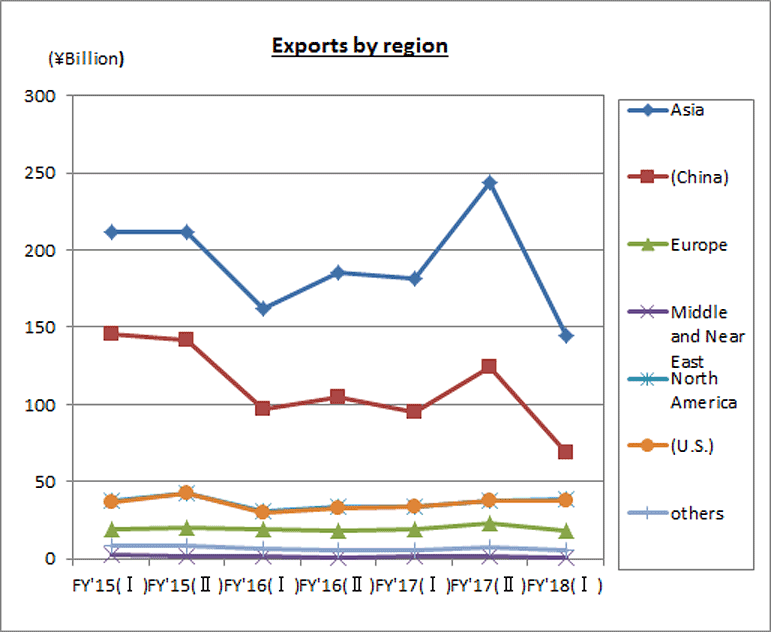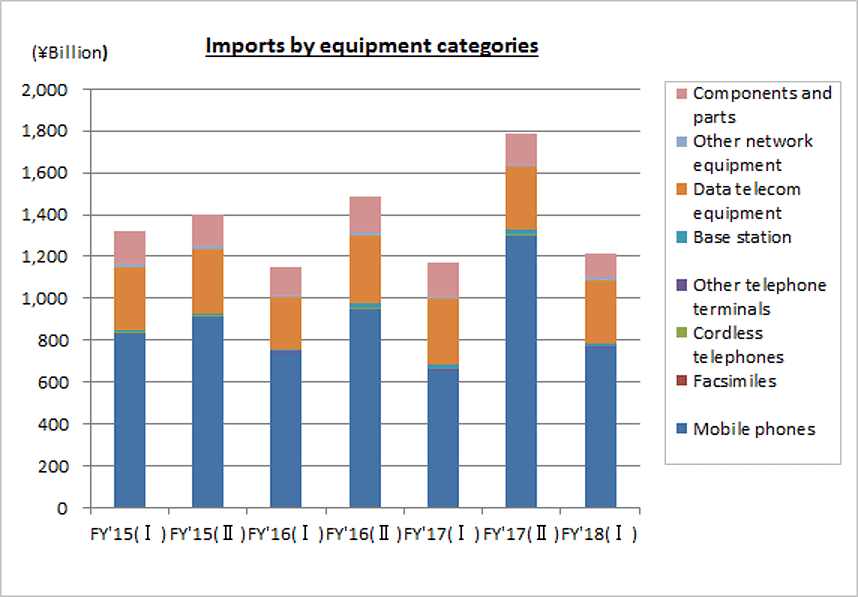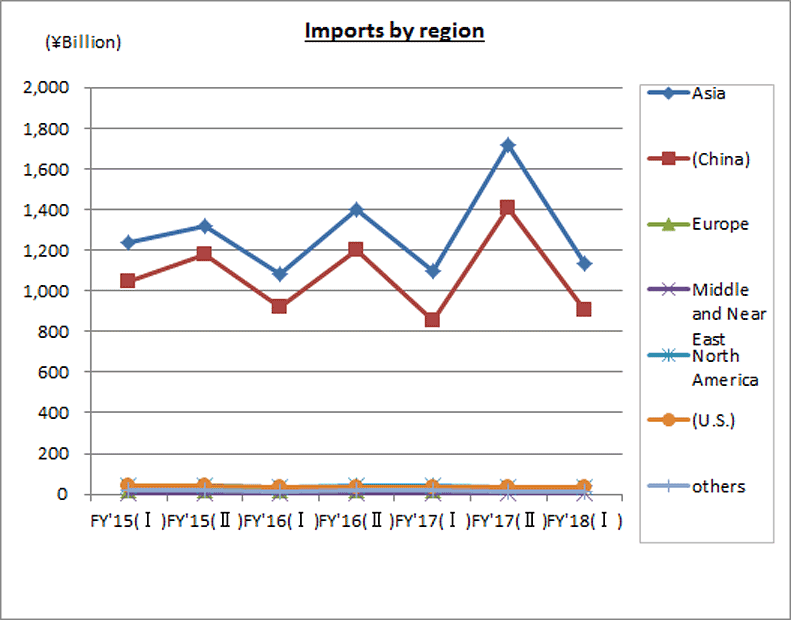The Communications and Information network Association of Japan (CIAJ: a general incorporated association) announces the telecommunication equipment production and trade figures for April through September, 2018 as follows.
The Cabinet Office of Japan announced a -1.2% real GDP (annual) growth for July – September (1st update), returning to negative growth after a pick up last quarter. Major contributing factors included the impact from natural disasters, which led to lower consumer spending and damage to factories producing equipment for export. Though many businesses reporting higher revenues and companies are investing to tackle labor shortages and aging facilities, which raises domestic demand, the current Japanese economy relies heavily on overseas demand and the slowing growth of economies abroad, especially China and the ongoing trade conflict, all contribute to slowing exports and increasing risk for the Japan.
The domestic telecommunication equipment market is experiencing negative demand growth with longer renewal cycles of mobile devices, lower investment in telecom infrastructure as 4G nears end-of-life before cutover to 5G, but momentum for 5G investment has yet to begin and lower demand for exports due to slowing economies abroad. Domestic production continues to decline year-over-year (YoY) with the ongoing shift of production overseas, but the domestic market size exceeded the figures for the first half (H1) of FY2016 and FY2017.
I. Domestic Market Trends (new category)
(Aggregated by CIAJ based on Indices of Industrial Production and Trade Statistics of Japan)
(1) FY2018 first half (H1) actual
The size of the domestic market (including the value of imports of foreign brands) was calculated from government figures, the Indices of Industrial Production and Trade Statistics of Japan, according to the following formula:
Domestic market size = value of domestic production – value of exports + value of imports
The total value of the domestic market for April through September was 1.207 trillion yen, or positive 3.9% growth over the same period in FY2017.
(2) Trend by categories
Actual figures by category for April through September were as follows:
Terminal equipment
844.0 billion yen (+10.5% over the same quarter of the previous year).Network equipment
362.7 billion yen (-8.7% over the same quarter of the previous year).
Domestic Market (by category, H1/H2)

II. Domestic Production
(Based on Indices of Industrial Production compiled by the Ministry of Exonomics, Trade and Industry)
(1) FY2018 H1 actual
The total value of production was 200.6 billion yen, or negative 18.9% growth over the same period in FY2017. There was continuing shift of manufacturing facilities abroad and the slowdown of global economies translated into less production targeting exports. Domestic production figures for mobile phones and network equipment were especially lower as mobile systems experienced a lull before the transition to the new 5G network.
(2) Trend by categories
Actual figures by category for April through September were as follows:
Wireline terminal equipment
25.8 billion yen (±0% over the same period of the previous year). Of which telephone sets was 1.7 billion yen (-4.1% over the same period of the previous year) and key telephones 8.1 billion yen (-4.0% over the same period of the previous year), intercoms 15.3 billion yen (+2.0% over the same period of the previous year) and facsimiles 700 million yen (+18.3% over the same period of the previous year). Most categories recorded lower YoY figures.
Mobile terminal equipment
62.9 billion yen (-24.8% over the same period of the previous year). Of which mobile phones was 42.9 billion yen (-30.3% over the same period of the previous year) and public-use PHS 500 million yen (-35.0% over the same period of the previous year). Demand for mobile phones was low, as the period was in between the 2-year contract renewal cycle, as well as aggressive campaigns by foreign brands.
Wireline network equipment
52.8 billion yen (-10.2% over the same period of the previous year). Of which central office switching systems was 4.0 billion yen (-14.6% over the same period of the previous year), PBXs was 2.9 billion yen (±0% over the same period of the previous year) and digital transmission equipment was 16.9 billion yen (-12.0% over the same period of the previous year) and other transmission equipment was 26.3 billion yen (-7.2% over the same period of the previous year). Despite healthy export demand for PBXs, the value of domestic production is following a downward trend. The same trend applies to digital transmission equipment.
Wireless network equipment
30.7 billion yen (-34.5% over the same period of the previous year). Of which fixed telecommunication devices was 11.9 billion yen (-23.1% over the same period of the previous year) and base station equipment was 18.8 billion yen (-40.1% over the same period of the previous year). Domestic production declined with the exception of base stations for the public sector emergency and MCA radio systems.
Network access equipment
13.0 billion yen (-27.1% over the same period of the previous year). Demand for network equipment decreased despite growth in LAN switches for data centers.
Wireline parts (includes relay equipment for wireline systems)
15.4 billion yen (+6.6% over the same period of the previous year). Increased overseas production of new smart phone models by Japanese as well as U.S. brands resulted in a higher figure.
III. Exports
(Compiled by CIAJ, based on based on Ministry of Finance’s “Trade Statistics”)
(1) FY2018 H1 actual
The total figure for exports for April through September was 208.4 billion yen, meaning the figure returned to negative growth for the first time in three periods at -13.7%. The overall slowdown in global economies and the decrease in production of smartphones in China for the Chinese and Asian markets resulted in a drop in the export of related parts.
In data communication equipment, demand for wireline network equipment, such as central office switching systems and digital transmission equipment continued to grow, but was not enough to out-balance the decline in wireless network equipment, as the market entered a transition period to new mobile technology. All together, the category fell below 60 billion yen for the first time in 12 periods.
In telephone and handsets, export of mobile phones to the U.S. recorded positive YoY growth since 2017 Q2 and continues into Q2 of 2018. The yen value of base station exports is small, but there was positive growth to the U.S., the EU and Latin and South America, while the export value to Asia decreased.
(2) Trend by categories
Actual figures from April through September by category are as follows (the facsimile category is no longer applied from January 2018):
- Telephone sets and terminal equipment 12.2 billion yen (+86.9% over the same period of the previous year)
Of which, mobile phones was 10.5 billion yen (+103.9% over the same period of the previous year), cordless handsets for landline phones was 180 million yen (-11.6% over the same period of the previous year), and other was 1.5 billion yen (+31.8% over the same period of the previous year). - Network equipment 62.7 billion yen (-12.8% over the same period of the previous year)
Of which, base stations was 2.7 billion yen (-9.2% over the same period of the previous year), data communication equipment was 58.2 billion yen (-11.8% over the same period of the previous year) and other network equipment was 1.8 billion yen (-38.4% over the same period of the previous year). - Parts (both wireline and wireless) 133.5 billion yen (-18.1% over the same period of the previous year)
(3) Actual figures by region
By region, Asia was 144.7 billion yen (-20.1% over the same period of the previous year), of which China was 69.0 billion yen (-27.7% over the same period of the previous year). North America was 38.2 billion yen (+12.4% over the same period of the previous year), of which the U.S. was 37.6 billion yen (+12.5% over the same period of the previous year). Europe was 18.4 billion yen (-3.7% over the same period of the previous year), of which the EU was 16.0 billion yen (-6.5% over the same period of the previous year).
The export of parts to China decreased to 45.5% of total exports. The production of smartphones among Asian countries other than China increased, especially in Vietnam and Singapore. The export of mobile phones to the U.S. was 9.5 billion yen (+163% over the same period of the previous year) and has recorded positive growth since 2017 Q2.
(4) Comparison and breakdown by regions
| First: | Asia | 69.4% (-5.5% over the same quarter of the previous year) |
| Second: | North America | 18.3% (+4.1% over the same quarter of the previous year) |
| Third: | Europe | 8.8% (+0.9% over the same quarter of the previous year) |
| Other regions: | 3.5% (+0.5% over the same quarter of the previous year) |
IV. Imports
(Compiled by CIAJ, based on based on Ministry of Finance’s “Trade Statistics”)
(1) FY2018 H1 actual
The total figure for exports from April through September was 1.211 trillion yen (+3.8% over the same period of the previous year). In mobile phones, there was a rise in imports of Japanese brand smartphones manufactured abroad as well as U.S. brands in Q2. Network equipment also decreased as the market entered a transition period to new mobile technology.
(2) Trend by categories
Actual figures by category are as follows (the facsimile category is no longer applied from January 2018):
- Telephone sets and terminal equipment 767.4 billion yen (+16.6% over the same period of the previous year)
Of which, mobile phones was 761.6 billion yen (+16.8% over the same period of the previous year), cordless handsets for landline phones was 2.7 billion yen (+3.8% over the same period of the previous year) and other was 3.1 billion yen (-9.6% over the same period of the previous year). - Network equipment 328.9 billion yen (-4.9% over the same period of the previous year)
Of which, base stations was 19.7 billion yen (-18.8% over the same period of the previous year), data communication equipment was 297.1 billion yen (-4.8% over the same period of the previous year) and other network equipment was 12.0 billion yen (+27.4% over the same period of the previous year). - Parts (both wireline and wireless) 114.5 billion yen (-29.6% over the same period of the previous year).
(3) Actual figures by region
By region, Asia was 1.133 trillion yen (+3.3% over the same period of the previous year), of which China was 903.2 billion yen (+5.4% over the same period of the previous year). North America was 34.3 billion yen (-10.1% over the same period of the previous year), of which the U.S. accounted for 31.7 billion yen (-15.4% over the same period of the previous year). Europe was 27.8 billion yen (+69.1% over the same period of the previous year), of which the EU was 27.5 billion yen (+73.9% over the same period of the previous year).
The import from Europe grew substantially for most categories, specifically mobile telephones (+162.0% over the same period of the previous year), base stations (+166% over the same period of the previous year), data communication equipment (+26% over the same period of the previous year) and parts (+291% over the same period of the previous year).
(4) Comparison and breakdown by regions
| First: | Asia | 93.6% (-0.3% over the same quarter of the previous year) |
| Second: | North America | 2.8% (-0.5% over the same quarter of the previous year) |
| Third: | Europe | 2.3% (+0.9% over the same quarter of the previous year) |
| Other regions: | 1.3% (-0.2% over the same quarter of the previous year) |
V. Trends in Orders Received and Shipped
(from CIAJ statistics)
(1) FY2018 H1 actual
CIAJ statistics for total orders received and shipped amounted to 731.7 billion yen (-13.8% over the same period of the previous year) for the period. Of which the total value of domestic shipments totaled 555.0 billion yen (-15.1% over the same period of the previous year) and exports was 176.8 billion yen (-9.4% over the same period of the previous year).
CIAJ statistics for total orders received and shipped = orders received and shipped by CIAJ member companies
(total orders received and shipped = value of shipments for the domestic market (domestic production + foreign production) = value of domestic production + value of imports of products produced abroad)
(2) Trend by categories
Actual figures by category for April through September were as follows:
- Wireline terminal equipment
276.9 billion yen (-5.4% over the same period of the previous year).
The telephone category grew in total together with imports of Japanese brand cordless handsets manufactured abroad. Exports of personal and office-use facsimiles (including multi-functioning devices) decreased with the slowdown in global economies. - Mobile terminal equipment
249.3 billion yen (-15.6% over the same period of the previous year).
The 2-year mobile contract coverage cycle led to a negative figure for this period, but signs of a recovery were seen from August. MCA/simple radio terminals did well among the other groups in this category. - Wireline network equipment
86.5 billion yen (-13.0% over the same period of the previous year).
Key telephone sets, modems and other transmission equipment category had positive growth, but was not enough to make up for drops in other categories. - Wireless network equipment
80.7 billion yen (-32.9% over the same period of the previous year).
Demand for base stations for public sector emergency systems/MCA radios was positive, but the figure for the category as a whole was negative. The figure for the entire category was significantly lower as the market entered a transition period to newer mobile technology. - Other network equipment
20.4 billion yen (+4.4% over the same period of the previous year).
Demand for data center equipment resulted in continued healthy growth for LAN switches. - Communication equipment parts
18.0 billion yen (-17.0% over the same period of the previous year).
For details, contact
Market Research
CIAJ
tel: 81-3-5403-9356 fax: 81-3-5403-9360
For more general inquiries, contact
Corporate Communications
CIAJ
tel: 81-3-5403-9351 fax: 81-3-5403-9360






